Appropriating Activity Theory #4: When Vygotsky Meets Dewey (2019)

This post is part of the "Appropriating Activity Theory" series, which reflects my creative journey of engaging with Activity Theory from 2015 to 2025.
by Oliver Ding
October 31, 2025
From 2019 to 2021, I worked on the Theory—Practice Connection centered around a simple diagram as a creative heuristic tool. The three-year journey took several strategic moves to scale its initial focus.
How did the diagram come? It was inspired by an academic debate between a Vygotsky scholar and a Dewey scholar.
When Vygotsky Meets Dewey (2019)
In August 2019, I read several academic papers centering on a debate between Jim Garrison, a philosopher and Dewey scholar, and Reijo Miettinen, an Activity theorist and Vygotsky scholar. They discussed the relationship between Deweyan pragmatism and cultural-historical activity theory, which was founded by the Soviet psychologist Lev Vygotsky.
Garrison argued that Activity Theory adopts a dualist approach due to its distinction between the internal and the external. He suggested that Dewey’s transactional theory of action offers a better framework for understanding human activity. Miettinen disagreed, claiming that Activity Theory is just as committed to anti-Cartesian monism as Dewey’s conception. He also argued that Activity Theory provides useful conceptual tools for transcending the dualism between the internal and the external.
This reading experience inspired me to create the WXMY diagram. Version 1.0 used the terms “Camp X,” “Camp Y,” and “Camp Z” because it initially focused on social groups. Later, I expanded the model to include any kind of entity, so I replaced the term “Camp” with “Container.”

In the context of the academic debate between Garrison and Miettinen:
- X represents John Dewey, and X′ represents Jim Garrison
- Y represents Lev Vygotsky, and Y′ represents Reijo Miettinen
- The debate itself corresponds to Container Z
In 2019, I didn’t use the WXMY diagram frequently — I only experimented with it a few times.
However, in March 2020, I revisited the diagram and applied it to a series of ideas:
March 22: “Ecological Structure”.
March 22: “Double Grid-Group”
March 23: “Boundary Innovation”
March 26: “Platform Container”
March 26: “Theory — Practice Coupling”
March 27: “Life Container”
It was an amazing experience! I became deeply engaged in visualizing a range of complex and abstract ideas using the WXMY diagram during that week. It seems that the week became a tipping point for the diagram.
The basic spatial structure of the WXMY diagram is a three-container model:
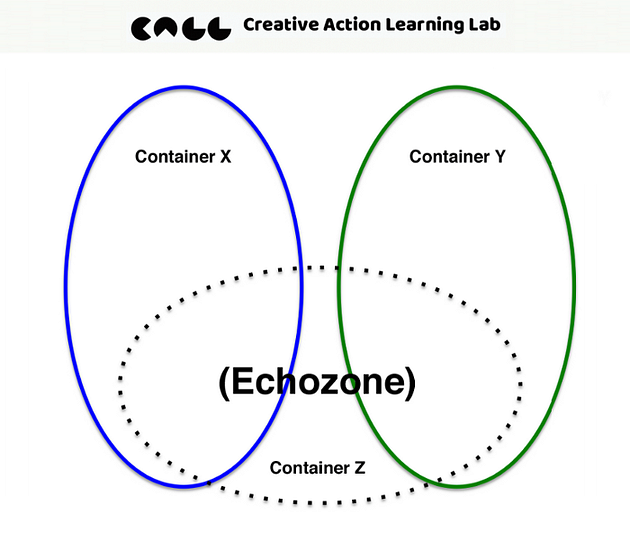
In this model, the middle container is also referred to as the Echozone, which is the first aspect of the WXMY diagram.
The concept of “Container” is the core of the Ecological Practice approach. By adjusting the quality and quantity of the Container, we can create advanced frameworks for discussing complex phenomena. The quality of the Container can be either potential or actual, and the quantity of the Container can be one or two. If we build a new framework using one potential container and two actual containers, the outcome is the diagram mentioned above.
I named the potential container (Container Z) Echozone — a creative space containing echoes between Container X and Container Y. The “Echo” in “Echozone” refers to a dialogue between two containers.
You can roughly give a Name to the third container. For example, in the diagram below, I named the Echozone “Service Thinking.” This term merely points toward a possible meaning — we don’t know exactly what “Service Thinking” means yet, but we can figure it out later. Of course, the name of the Echozone can also be changed.

The second aspect of the WXMY diagram is the Figure–Ground relationship. The space inside the Echozone is the Figure, while the space outside is the Ground. In most cases, when using the WXMY diagram, we focus on the Figure, which represents the creative space for dialogue (see the example below).
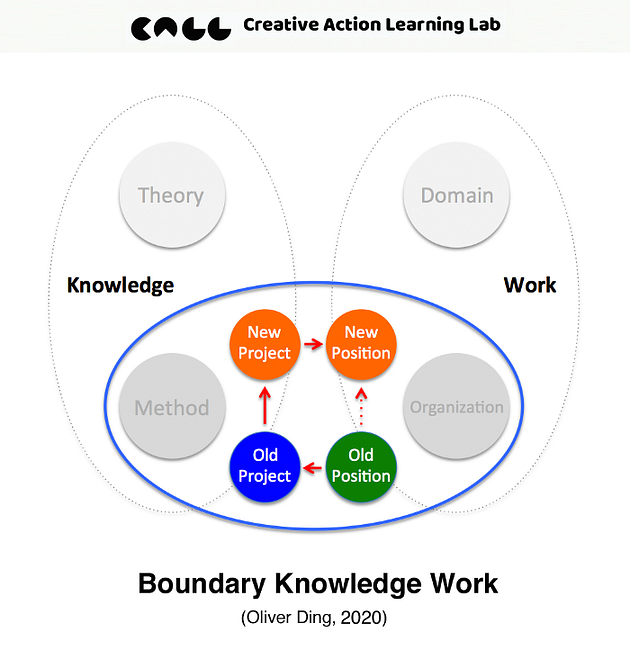
The third aspect is Symmetry. Once you define the relationship between two items within Container X, you must apply the same or a similar type of relationship to Container Y in order to maintain symmetry.
This structure forms the foundation of the ECHO Way and all the related ideas that followed.
The ECHO Journey (2019 - 2021)
In April 2025, after revisiting my experience, I identified a three-year creative journey from 2019 to 2021 centered around a model called Echozone. I named this journey ECHO.
From 2019 to 2021, I worked on the Theory—Practice Connection centered around the WXMY diagram and the Echozone model as a creative heuristic tool. The three-year journey took several strategic moves to scale its initial focus. We can roughly highlight three projects and discover three themes for each year.
- 2019: The React Project → Practice-based Reflection
- 2020: The Activity U Project → Theory-based Curation
- 2021: The ECHO Way project → Theory — Practice Dialogue
However, the real journey is more complicated than this simple narrative, as illustrated in the diagram below.
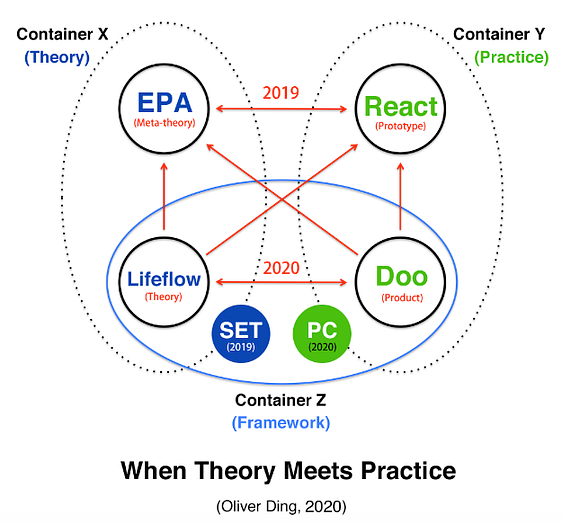
In 2019, I created the WXMY diagram, a foundational heuristic that catalyzed the development of new diagrams and knowledge frameworks. During the same year, I prototyped a web application through the React Project and initiated a reflective inquiry, Rethink Social Design, which led to the creation of the “SET” framework.
In 2020, I worked on the DOO Project, the operational outcome of the React Project. Following its release, I conducted three months of user interviews, then wrote a whitepaper that integrated theoretical perspectives. This led to the Platform Container framework, designed to analyze digital transformation.
After comparing the SET framework (2019) and the Platform Container framework (2020), I realized there are several different levels of knowing. This insight inspired me to create the When Theory Meets Practice model.
That same year marked a pivot from practice to theory. I initiated the Knowledge Curation journey, beginning with Activity U, a project focused on single-theory curation. In 2021, I expanded this approach with D as Diagramming, a project exploring multiple-theory curation. Both were grounded in the When Theory Meets Practice model.
In April 2021, I drafted a book titled The ECHO Way: Echozone and Boundary Knowledge Work, which captured the trajectory of this evolving journey. Later, I launched The ECHO Way (V2.0) — a meta-framework that extended its applications beyond the theory-practice connection.
The “SET” Framework (2019)
One of the theories I engaged with between 2014 and 2018 was Activity Theory. During this period, I worked as an information architect and interaction designer at a digital startup. While reading books and papers on Activity Theory and Ecological Psychology, I connected THEORY and PRACTICE by focusing on the field of HCI (human-computer interaction) research and applying these concepts to real-world projects.
From 2017 to 2018, I worked on a project aimed at developing a one-to-one video talk mobile app. This project inspired me to deeply reflect on social interaction design and the development of social action platforms. Later, I worked on several other similar projects that shared the same structure. To explore this further, I coined the term “Structured Engagement” and defined it as a social interaction pattern with the following components:
- Action: What do people do?
- Relation: How do people connect?
- Settings: Where do people act?
In July 2019, I began a theoretical project called Rethinking Social Design. I incorporated several concepts from Activity Theory and Ecological Psychology to develop a new framework for exploring the theme of “Structured Engagement,” which led to the creation of the SET (Structured Engagement Theory) framework.
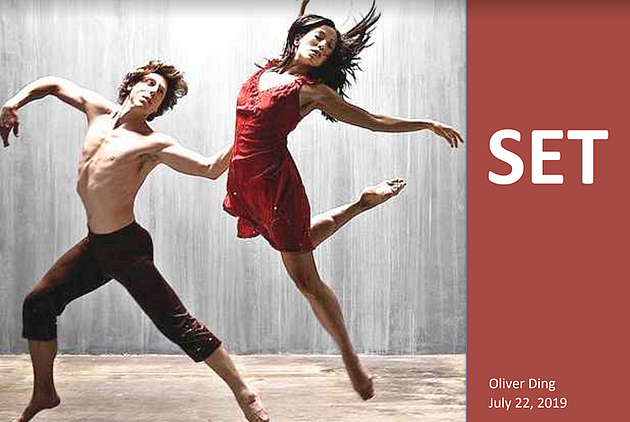
The unit of analysis of the SET framework is the pan-interpersonal level.

Traditional social psychological and sociological theories typically use real interpersonal actions or social roles as units of analysis. Inspired by interaction design and digital social practices, I adopted the term “Persona” from the field of User Experience to define an intermediary entity between Person and Social Role.
- Person
- Persona
- Social Role
This approach allows us to study pluralistic social interaction in the age of digital platforms. See the diagram below.

The entire framework explores a set of concepts under three key aspects: Action, Relation, and Settings.

Within this framework, I developed a series of diagrams as tools for research and reflection.
This was both a Creation and a Curation project. While adopting concepts from Activity Theory and Ecological Psychology, I also developed new concepts and models.
The name “SET” is inspired by Behavior Settings Theory, one of the theoretical approaches of Ecological Psychology. Later, I applied this name to another framework, as seen in The SET Framework [Hybrid Approach].
The DOO Project (2020)
In 2019, I worked on the React project, which aimed to develop a platform to support social collaborative actions. I used the SET framework to reflect on its design.
In early 2020, the React project launched its version 1.0 product (which we’ll call DOO). From January to March 2020, I was occupied with public testing, user interviews, and feature design. On March 20, 2020, I completed a 100-page whitepaper reflecting on the DOO product. Based on user interviews and internal discussions, I incorporated several theoretical concepts from Activity Theory and Ecological Psychology for theory-based reflection.
In the whitepaper, I introduced a new concept called the “Platform Container,” inspired by the Ecological Practice approach (which I initially introduced in my 2019 book Curativity).
In April 2020, I separated the concept of “Platform Container” from the DOO project and applied it to discuss digital transformation.
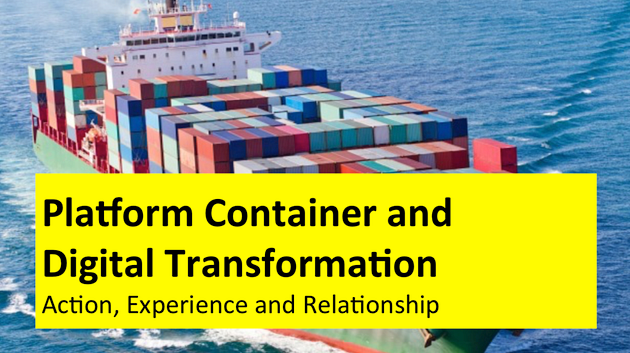
I created a 121-slide conceptual deck and developed a series of frameworks, one of which is the Double Grid-Group Framework.
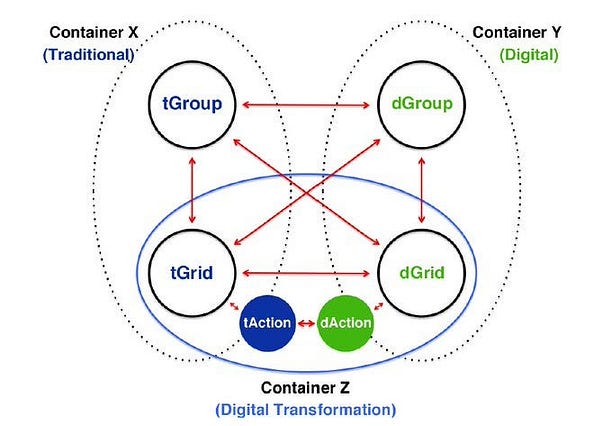
More details can be found in Platform Curativity and Digital Transformation.
When Theory Meets Practice (April 2020)
The subtitle of the slide deck is “Action, Experience, and Relationship.” These three keywords were central themes of the SET framework (2019), as discussed earlier.
In a discussion with a friend, I compared the SET framework with the Platform Container framework and made the following observation:
Compared to the current framework, the SET framework was more scattered and loosely organized, lacking a coherent theoretical foundation. In contrast, Platform Container begins with a clear theoretical concept that shapes and structures the entire framework, representing a step forward in terms of conceptual depth…
The SET framework was both messy and abstract, without a simple, actionable path for supporting practice. By contrast, the Platform Container framework not only builds a deeper theoretical foundation but also offers more practical utility.
Reflecting on the creation processes of both, it feels quite strange.
Both frameworks were developed in the context of the DOO project and were influenced by the Ecological Practice approach. The key difference lies in the level of contextual specificity.
At this stage, the DOO project has taken shape as a concrete product, generating a wide range of real-world experiences and thematic inquiries. Meanwhile, Ecological Practice approach has developed a more specific analytical framework — the life container framework.
The convergence of these two — Platform Container and Life Container — represents a more refined and integrated form of theory–practice coupling. In comparison, the SET framework’s development reflected a more preliminary, less integrated coupling of theory and practice.
This reflection inspired me to make the diagram below.

In the diagram above, “EPA” refers to the Ecological Practice approach, “Lifeflow” refers to the Life Container framework, and “PC” refers to the Platform Container framework.
The diagram represents two examples of the “THEORY — PRACTICE” connection.
- The SET framework (2019): EPA (Theory) — React (Practice)
- The Platform Container framework (2020): Lifeflow (Theory) — DOO (Practice)
It should be noted that in 2019, the React project was still in the prototype development phase; at that time, we didn’t have a final product. Meanwhile, the Ecological Practice approach was in its initial stage.
In 2020, the React project launched its final product, DOO, while the Ecological Practice approach developed a more specific analytical framework — the Life Container framework.
Therefore, the Lifeflow-DOO connection is more concrete than the EPA-React connection.
This insight inspired me to develop the When Theory Meets Practice model. See the diagram below.
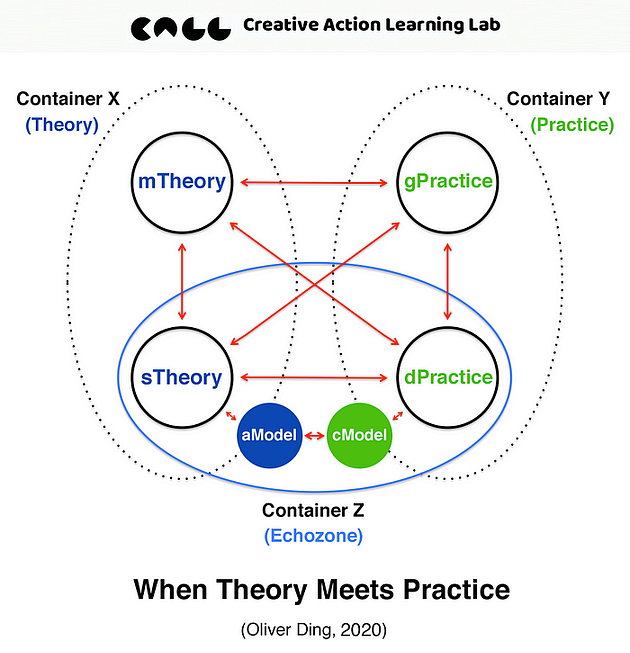
There is also a simpler version: Theme U. See the diagram below.
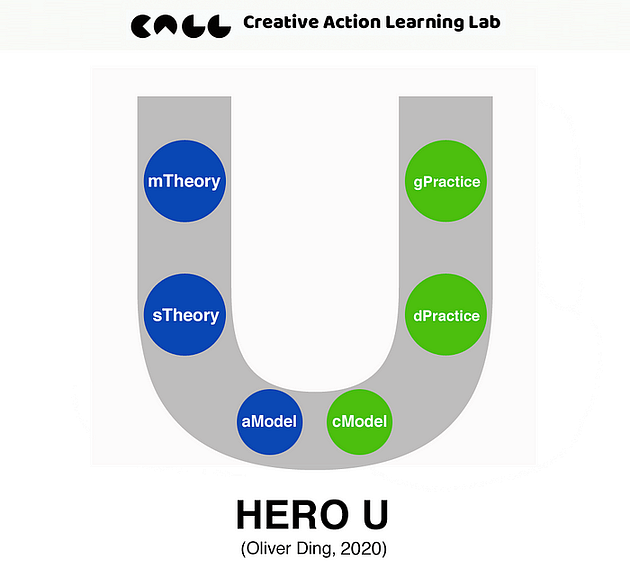
The “U” diagram above resembles a pipeline with balls. It represents six types of “Objects of Knowing.” Let’s break down the terms I used in the diagram:
mTheory: Meta-theory
sTheory: Specific Theory
aModel: Abstract Model
cModel: Concrete Model
dPractice: Domain Practice
gPractice: General Practice
Meta-theory (mTheory) refers to philosophical approaches or theoretical perspectives that guide researchers in developing their own theory in a specific domain.
Specific Theory (sTheory) refers to discipline-dependent theories. These theories apply only to particular domains or fields.
Abstract Models (aModel) are high-level models that connect theoretical approaches with specific domains.
Concrete Models (cModel) are lower-level models with detailed guidance for domain practices.
Domain Practice (dPractice) refers to a person reflecting on and thinking about the domain they are working in.
General Practice (gPractice) refers to everyday life as a general context of knowing.
There is an assumption behind the framework. According to Construal level theory (CLT), a social psychology theory that describes the relationship between psychological distance and the extent to which people think abstractly or concretely:
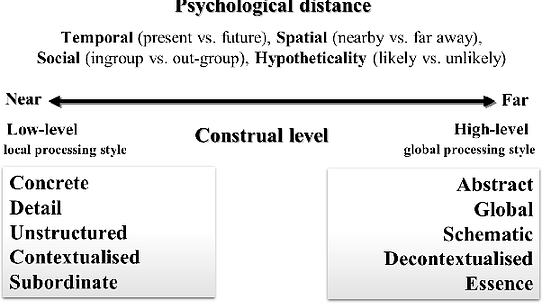
In their article Construal-Level Theory of Psychological Distance,Yaacov Trope and Nira Liberman state, “According to CLT, then, people traverse different psychological distances by using similar mental construal processes. Because the various distances have the same egocentric reference point, they should all be cognitively related to each other and similarly affect and be affected by level of construal. As psychological distance increases, construals would become more abstract, and as level of abstraction increases, so too would the psychological distances people envisage. Construal levels thus expand and contract one’s mental horizon.”
I believe the six types of “Objects of Knowing” in the Theme U framework require different construal levels. Meta-theory (mTheory) corresponds to a high-level construal, while General Practice (gPractice) corresponds to a low-level construal.
The HERO U Framework (June 2020)
In June 2020, based on the Theme U diagram, I added a second dimension that represents a set of “Personal Conditions of Knowing.” The final version of the diagram resulted in a new framework that describes the structure and dynamics of knowing.
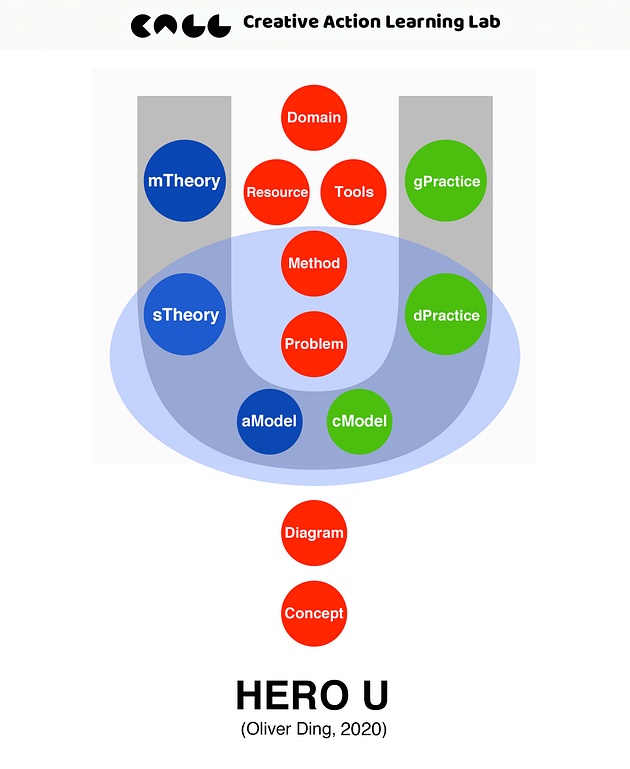
I consider this framework to be “an ecological approach” to knowing because it references the structure of “organism (personal conditions of knowing) → action (knowing) → environment (objects of knowing).”
There are many multi-level knowledge models, such as Gowin’s Vee diagram, Meta-modeling Methodology (M3), and diSessa ’s Knowledge in Pieces (KiP), among others. While HERO U shares the concept of construal levels with these models on the cognitive dimension, HERO U introduces an additional dimension: personal conditions.
Later, I used three diagrams to represent the HERO U model and transformed it into a toolkit under a new name: The ECHO Way.
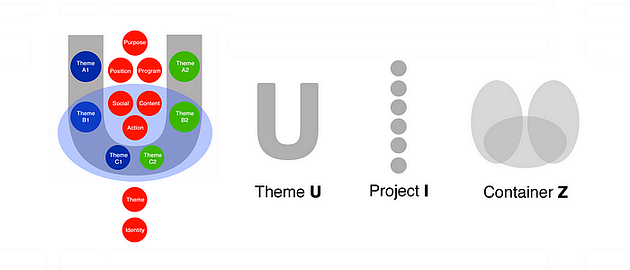
In the ECHO Way, the “personal conditions” dimension was redefined as “Project I,” linking to the Developmental Project model.
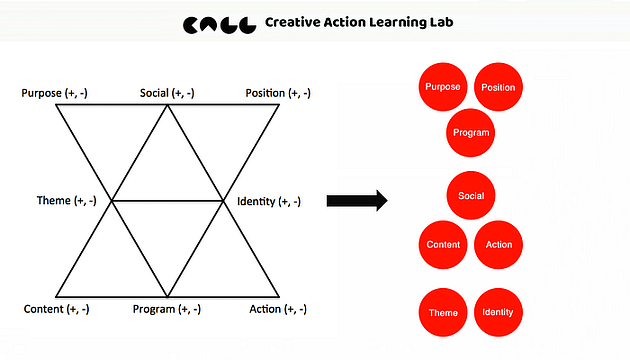
The ECHO Way offers a systemic approach to connect THEORY and PRACTICE, incorporating both thinking and doing.
The HERO U Framework was the seed of the Activity U project, which led to the whole journey of building the Activity Analysis Center.
Note
This article is an excerpt from [Wonder and Wander] The ECHO Journey (2019–2021). The full table of contents is provided below for reference.
Contents
Part 1: The Background
1.1 A Jiangyang Boy
1.2 A Reflective Practitioner
1.3 The Context of Epistemic Development
1.4 Personal Psychobiography as Context
Part 2: The ECHO Journey
2.1 When Vygotsky Meets Dewey (2019)
2.2 The “SET” Framework (2019)
2.3 The DOO Project (2020)
2.4 When Theory Meets Practice (April 2020)
2.5 The HERO U Framework (June 2020)
2.6 The Activity U Project (August 2020 to March 2021)
2.7 The “D as Diagramming” Project (2021)
2.8 The ECHO Way (April 2021) and Beyond
Part 3: The Reflection
3.1 The Landscape of the ECHO Way
3.2 The Creative Dialogue Method
3.3 The “WXMY” Diagram and Beyond
3.4 The Third Container: The Magic of Echozone
3.5 Moving between Thematic Spaces
3.6 Theory, Practice, and Innovation
v1.0 - April 24, 2025 - 2,711 words
